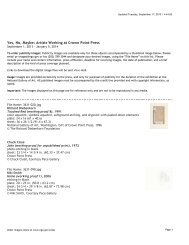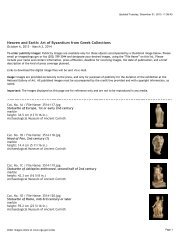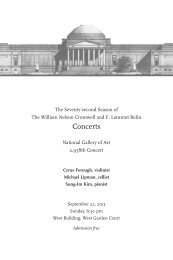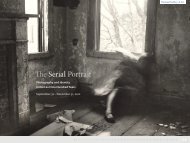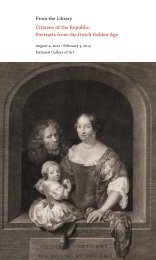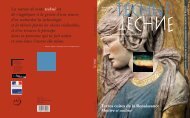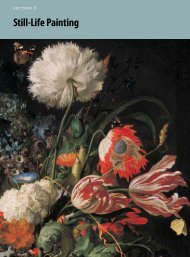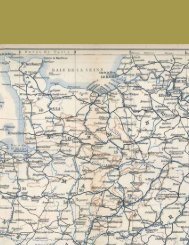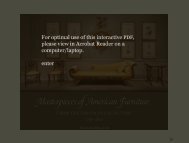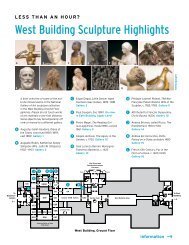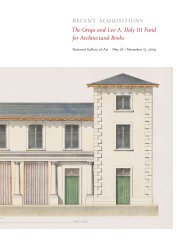Fall Film Calendar - National Gallery of Art
Fall Film Calendar - National Gallery of Art
Fall Film Calendar - National Gallery of Art
Create successful ePaper yourself
Turn your PDF publications into a flip-book with our unique Google optimized e-Paper software.
10 11<br />
absurdist sight gags and pioneering video effects, novel experiments<br />
in network TV’s early years. This program brings together a variety<br />
<strong>of</strong> dada-like sketches, from the silent Eugene Show to the musical<br />
Nairobi Trio to a Dutch Masters commercial in which Kovacs smokes<br />
a cigar under water. The comedian’s love for classical music, fostered<br />
by his wife and collaborator Edie Adams, blossomed on the shows<br />
<strong>of</strong> the late 1950s, and several <strong>of</strong> his “sound into sight” musical pieces<br />
from the ABC specials — early masterworks <strong>of</strong> video art — are also<br />
part <strong>of</strong> this mix. A discussion with three Kovacs historians — Bruce<br />
Bennett, David Bianculli, and Ben Model — follows the screening.<br />
(Total running time approximately 120 minutes)<br />
CINé-CONCERT: AlICE GUy BlAChé, TRANSATlANTIC SITES OF<br />
CINéMA NOUVEAU<br />
Musical accompaniment by Kim and Kathryn Kluge<br />
Sat Nov 10 (2:00)<br />
Alice Guy Blaché (1873 – 1968) is a unique figure in the history <strong>of</strong><br />
cinema — a woman positioned squarely at the front lines <strong>of</strong> international<br />
technological change that first distinguished the cinema as<br />
a form <strong>of</strong> mass entertainment. From production and distribution to<br />
early sound technology and independent direction, she participated<br />
in all aspects <strong>of</strong> the evolving motion picture business. This program<br />
features a selection <strong>of</strong> early films that Guy made in France for<br />
Gaumont, followed by restored single-reel subjects produced by her<br />
American company Solax, and finally a reconstruction <strong>of</strong> one <strong>of</strong> her<br />
three surviving independent features. The original score by composers<br />
Kim and Kathryn Kluge creates a conversation between past and<br />
present. The program is presented in association with the University<br />
<strong>of</strong> Maryland symposium “Alice Guy Blaché: Transatlantic Sites<br />
<strong>of</strong> Cinéma Nouveau, 1896 – 1920.” With special thanks to Caroline<br />
Eades, Elizabeth Papazian, Brian Real, Kim Tomadjoglou, Swedish<br />
<strong>Film</strong> Institute, Embassy <strong>of</strong> France, and Library <strong>of</strong> Congress. <strong>Film</strong>s on<br />
the program include: Alice Guy tourne une phonoscène (1905), early<br />
Gaumont films from the Sieurin Collection (1899 – 1900), Five O’Clock<br />
Tea (1905), Greater Love Hath No Man (1911), Mixed Pets (1911), <strong>Fall</strong>ing<br />
Leaves (1912), The Ocean Waif (1916), and Parson Sue (1912). (Total<br />
running time approximately 100 minutes, followed by discussion)<br />
lEAVING<br />
Sat Nov 17 (2:00)<br />
Václav Havel (1936 – 2011) — poet, playwright, and cherished first<br />
president <strong>of</strong> the Czech Republic — returned to the stage in 2008 with<br />
the new play Leaving (Odcházení). He adapted this absurdist comedy,<br />
in which an ex-government <strong>of</strong>ficial tries to reenter his former life, for<br />
the screen. As the action unfolds on a rural estate, comparisons to<br />
Havel’s own life become clear: “Before the 1989 Revolution, I had an<br />
idea for a character like King Lear, who loses power. It might have<br />
been the influence <strong>of</strong> the generation <strong>of</strong> 1968 — the people who had<br />
been party members . . . after ’68 they were thrown out and started<br />
to live ordinary lives, and they pretended that they didn’t mind, but<br />
in fact they did” — Václav Havel. (2011, Czech with subtitles, DCP,<br />
94 minutes)<br />
MARINA ABRAMOVIć: ThE ARTIST IS PRESENT<br />
Sat Nov 17 (4:00), Sun Nov 18 (4:30)<br />
Over half a million visitors to Marina Abramović’s groundbreaking<br />
2010 Museum <strong>of</strong> Modern <strong>Art</strong> retrospective lined up for hours for the<br />
most alluring aspect <strong>of</strong> this show — a chance to sit opposite Marina at<br />
a table and silently stare, as she stared back. Many were completely<br />
devastated by this rigorous, disquieting, and <strong>of</strong>ten moving experience.<br />
Marina Abramović: The <strong>Art</strong>ist Is Present chronicles not only<br />
the landmark exhibition but the intriguingly evocative career <strong>of</strong> this<br />
Serbia-born, New York – based performance artist, one <strong>of</strong> the most<br />
charismatic public figures <strong>of</strong> our time. (Matthew Akers, 2011, DCP,<br />
106 minutes)<br />
CINé-CONCERT: KINDRED OF ThE DUST<br />
Donald Sosin and Joanna Seaton, piano and voice<br />
Sat Nov 24 (1:00)<br />
Raoul Walsh’s 1922 silent melodrama <strong>of</strong> romantic intrigue in a northwest<br />
logging town, based on a popular novel by the prolific Peter B.<br />
Kyne, features Walsh’s wife, Miriam Cooper, as Nan <strong>of</strong> the Sawdust<br />
Pile, a wronged woman who returns to her hometown to find that her<br />
old sweetheart still loves her but cannot marry her. <strong>Art</strong> direction is by<br />
William Cameron Menzies, who moved on to one <strong>of</strong> the most brilliant<br />
careers in Hollywood production design. Pianist Donald Sosin and




